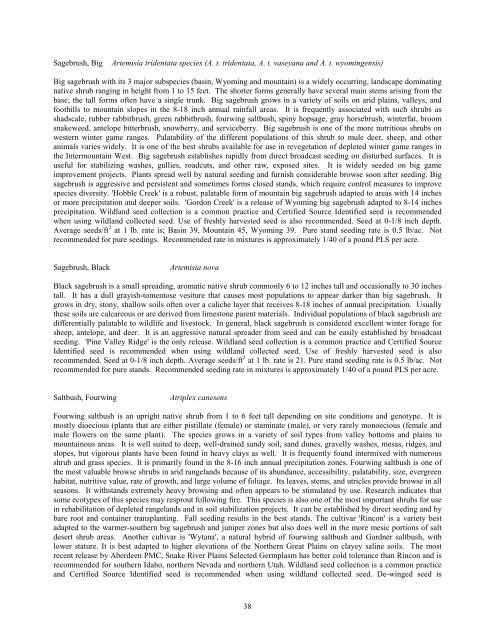Idaho Plant Materials Technical Note No. 24
Idaho Plant Materials Technical Note No. 24
Idaho Plant Materials Technical Note No. 24
Create successful ePaper yourself
Turn your PDF publications into a flip-book with our unique Google optimized e-Paper software.
Sagebrush, Big<br />
Artemisia tridentata species (A. t. tridentata, A. t. vaseyana and A. t. wyomingensis)<br />
Big sagebrush with its 3 major subspecies (basin, Wyoming and mountain) is a widely occurring, landscape dominating<br />
native shrub ranging in height from 1 to 15 feet. The shorter forms generally have several main stems arising from the<br />
base; the tall forms often have a single trunk. Big sagebrush grows in a variety of soils on arid plains, valleys, and<br />
foothills to mountain slopes in the 8-18 inch annual rainfall areas. It is frequently associated with such shrubs as<br />
shadscale, rubber rabbitbrush, green rabbitbrush, fourwing saltbush, spiny hopsage, gray horsebrush, winterfat, broom<br />
snakeweed, antelope bitterbrush, snowberry, and serviceberry. Big sagebrush is one of the more nutritious shrubs on<br />
western winter game ranges. Palatability of the different populations of this shrub to mule deer, sheep, and other<br />
animals varies widely. It is one of the best shrubs available for use in revegetation of depleted winter game ranges in<br />
the Intermountain West. Big sagebrush establishes rapidly from direct broadcast seeding on disturbed surfaces. It is<br />
useful for stabilizing washes, gullies, roadcuts, and other raw, exposed sites. It is widely seeded on big game<br />
improvement projects. <strong>Plant</strong>s spread well by natural seeding and furnish considerable browse soon after seeding. Big<br />
sagebrush is aggressive and persistent and sometimes forms closed stands, which require control measures to improve<br />
species diversity. 'Hobble Creek' is a robust, palatable form of mountain big sagebrush adapted to areas with 14 inches<br />
or more precipitation and deeper soils. 'Gordon Creek' is a release of Wyoming big sagebrush adapted to 8-14 inches<br />
precipitation. Wildland seed collection is a common practice and Certified Source Identified seed is recommended<br />
when using wildland collected seed. Use of freshly harvested seed is also recommended. Seed at 0-1/8 inch depth.<br />
Average seeds/ft 2 at 1 lb. rate is; Basin 39, Mountain 45, Wyoming 39. Pure stand seeding rate is 0.5 lb/ac. <strong>No</strong>t<br />
recommended for pure seedings. Recommended rate in mixtures is approximately 1/40 of a pound PLS per acre.<br />
Sagebrush, Black<br />
Artemisia nova<br />
Black sagebrush is a small spreading, aromatic native shrub commonly 6 to 12 inches tall and occasionally to 30 inches<br />
tall. It has a dull grayish-tomentose vesiture that causes most populations to appear darker than big sagebrush. It<br />
grows in dry, stony, shallow soils often over a caliche layer that receives 8-18 inches of annual precipitation. Usually<br />
these soils are calcareous or are derived from limestone parent materials. Individual populations of black sagebrush are<br />
differentially palatable to wildlife and livestock. In general, black sagebrush is considered excellent winter forage for<br />
sheep, antelope, and deer. It is an aggressive natural spreader from seed and can be easily established by broadcast<br />
seeding. 'Pine Valley Ridge' is the only release. Wildland seed collection is a common practice and Certified Source<br />
Identified seed is recommended when using wildland collected seed. Use of freshly harvested seed is also<br />
recommended. Seed at 0-1/8 inch depth. Average seeds/ft 2 at 1 lb. rate is 21. Pure stand seeding rate is 0.5 lb/ac. <strong>No</strong>t<br />
recommended for pure stands. Recommended seeding rate in mixtures is approximately 1/40 of a pound PLS per acre.<br />
Saltbush, Fourwing<br />
Atriplex canesens<br />
Fourwing saltbush is an upright native shrub from 1 to 6 feet tall depending on site conditions and genotype. It is<br />
mostly dioecious (plants that are either pistillate (female) or staminate (male), or very rarely monoecious (female and<br />
male flowers on the same plant). The species grows in a variety of soil types from valley bottoms and plains to<br />
mountainous areas. It is well suited to deep, well-drained sandy soil, sand dunes, gravelly washes, mesas, ridges, and<br />
slopes, but vigorous plants have been found in heavy clays as well. It is frequently found intermixed with numerous<br />
shrub and grass species. It is primarily found in the 8-16 inch annual precipitation zones. Fourwing saltbush is one of<br />
the most valuable browse shrubs in arid rangelands because of its abundance, accessibility, palatability, size, evergreen<br />
habitat, nutritive value, rate of growth, and large volume of foliage. Its leaves, stems, and utricles provide browse in all<br />
seasons. It withstands extremely heavy browsing and often appears to be stimulated by use. Research indicates that<br />
some ecotypes of this species may resprout following fire. This species is also one of the most important shrubs for use<br />
in rehabilitation of depleted rangelands and in soil stabilization projects. It can be established by direct seeding and by<br />
bare root and container transplanting. Fall seeding results in the best stands. The cultivar 'Rincon' is a variety best<br />
adapted to the warmer-southern big sagebrush and juniper zones but also does well in the more mesic portions of salt<br />
desert shrub areas. Another cultivar is 'Wytana', a natural hybrid of fourwing saltbush and Gardner saltbush, with<br />
lower stature. It is best adapted to higher elevations of the <strong>No</strong>rthern Great Plains on clayey saline soils. The most<br />
recent release by Aberdeen PMC, Snake River Plains Selected Germplasm has better cold tolerance than Rincon and is<br />
recommended for southern <strong>Idaho</strong>, northern Nevada and northern Utah. Wildland seed collection is a common practice<br />
and Certified Source Identified seed is recommended when using wildland collected seed. De-winged seed is<br />
38
















